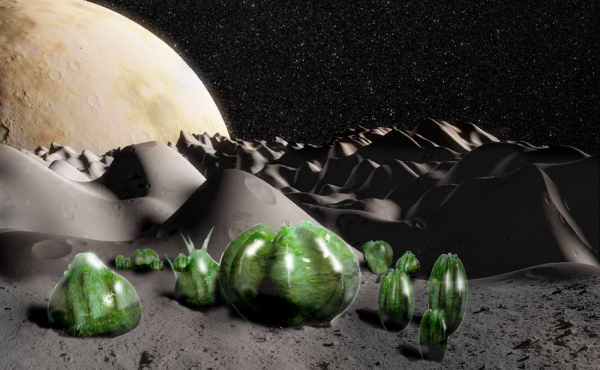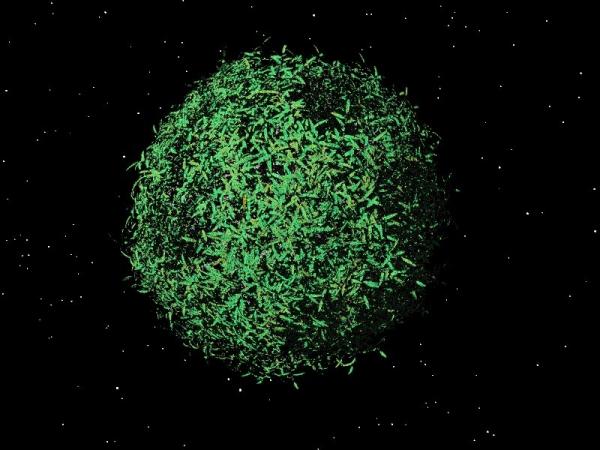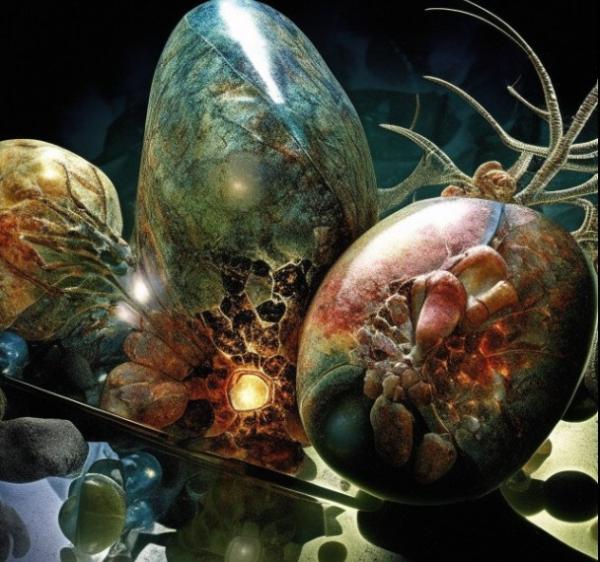BY LETTER
Vacuum Flora and Gardens
 Image from Steve Bowers | |
| Terrarium plants on an airless moon | |
Vacuum Flora
Many varieties of vacuum-adapted plants and other photosynthetic astragens can be found throughout the Terragen Sphere. These are typically neogens or splices, though some are naturally-evolved xenobiota. Regardless of their origin, they are most commonly found growing on carbonaceous asteroids or comets with eccentric trajectories, and rarely in open space, though several exceptions exist. Many species require some amount of sophont cultivation in order to survive and thrive.While the totality of such organisms is too large and diverse to fully detail here, certain features and morphotypes are widely employed in many of them, regardless of origin or physiology, and can be regarded as examples of attractor states or convergent design evolution.
Common Adaptations
There are a number of specific features commonly included in a majority of vacuum flora and other astragens. These include physiological adaptations that allow the organisms to survive freezing solid or boiling dry for extended periods, and then quickly resuming normal metabolic activity with the return of more amenable conditions. Roots or similar structures that reach deep into the substrate and conduct heat very efficiently are also extremely common, and function as thermocouples allowing the organisms to maintain consistent internal temperatures more effectively. Integuments that can rapidly change between highly reflective and highly absorbent to deal with varying levels of irradiation are widespread, as are tissues able to tolerate and process the often chemically and structurally complex and inhospitable substrates found in many vacuum environments.A brief list of representative examples of vacuum flora is provided below:
Vacuum Lichen
Terragen lichens are composite organisms consisting of a fungal partner which produces a durable structure called a thallus, which provides a protected environment for photosynthetic algae and cyanobacteria to grow in a mutualistic relationship. They are among the most self-sufficient and toughest macroscopic lifeforms that evolved on Earth, and were among the first whose survivability in space was researched. While unmodified varieties cannot actively grow under such conditions, they are able to survive several years of exposure and provided a sort of proof of concept for later vacuum organisms.Many types of vacuum lichen are genetically derived from actual lichens, but more generally the term may refer to any "lichenised" commensal lifeforms that employ a similar morphotype, with populations of autotrophic or producer organisms living embedded within and protected by a larger heterotroph or consumer organism, which physically shields them from the stresses of the environment with highly resilient tissues, and in turn relies on the nutrients they produce. Vacuum Bladderwrack and Terrarium Plants may be regarded as "lichenised" bionts in this more general sense.
Vacuum lichens usually fulfill a role in vacuum gardens similar to ground cover in more traditional planetary gardens, and are especially appreciated for their huge variety of often bizarre and ornate growth forms and textures.
Vacuum Cacti
Cactaceae is a plant family originating on Earth, that has historically been heavily utilized and much loved by humans and later, other Terragen sophonts. They were among the first families of flowering plants to be engineered to withstand life in vacuum environments while remaining fairly faithful to their baseline genetics, and remain extremely popular.Terrestrial cacti were selected for their durability and suitable photosynthetic process, as well as the somewhat fanciful idea that such desert-dwelling plants would be "obviously" ideal for the lunar regolith and Martian soils. In fact, the required adaptations and genetic engineering tasks were numerous regardless of whether cacti or other plants were used. The first vacuum cacti (of lines that are still extant and popular) had such narrow temperature tolerances that they were only suited for space station hulls and near-Earth asteroids with day lengths under 50 hours. The problems of vacuum adaptation were numerous: carbon dioxide and nitrogen had to be acquired from new sources; regoliths and non-terrestrial soils were typically moisture- and nutrient-deficient; near-surface soil temperatures could swing from +125 to -125C even in suitable illumination levels; and so on.
Early cacti avoided solving all those problems. Instead, they were gardened in nutrient-rich, watered soils on artificial satellites, or outside asteroid bases supporting their research and development. Here, temperature could also be regulated by assorted means such as shading, soil heaters, or predictable diurnal temperature swings. Moisture was typically provided in vacuum-stable forms like hydrated materials (e.g., clays) or as frost below an insulating regolith crust.
Such vacuum cacti were not robust and fast growing like later astragens, but they demonstrated that plants could survive in vacuum. The key success was in adopting crassulacean acid metabolism (CAM) and C4 photosynthesis processes to the rigors of vacuum: the early vacuum cacti first reduced carbon dioxide, oxygen, and water loss rates, and later halted them almost entirely. They instead carefully held and recycled those materials, typically shuttling them between intracellular spaces and active areas using techniques that often varied by engineering design group. In addition, vacuum cacti often had roots and metabolisms tolerant of aggressive chemicals, like those found in asteroid regolith.
Other vacuum adaptations were also developed prior to the Technocalypse. Vacuum cacti were adapted to extended solar heating by four major techniques, not all of which were present in a given vacuum cactus species: photoresponsive skins that altered albedo; water-costly transpiration cooling; high thermal mass, to slow temperature change of the plant; and geothermal heat exchange, using sap circulation through roots in cool regolith to keep the plant cool. Low temperatures were addressed by thermal mass; metabolic heat generation, typically using sugars and oxygen accumulated in daytime; and geothermal heat exchange. Designers also worked throughout the pre-Technocalypse era to improve the tolerance of the plant's biology to heat and cold. Freeze-tolerant cacti were an early success in adapting the plants to the chill of extended darkness, like the lunar night — the plants could simply freeze without harm and then thaw during the day.
Finally, pollination and seed dispersal were often addressed by gaseous or mechanical means. The mechanical dispersion of seeds and pollen was readily adapted from terrestrial plants like the Himalayan Balsam, while translating the gaseous dispersion of the Puffball Fungus followed a few decades later.
Terrarium Plants
Terrarium plants are a distinct offshoot of vacuum cacti created for aesthetic and academic purposes. The original concept of terrarium plants was to create a closed internal ecosystem using additional, symbiotic species that would live within the plant. Such an idea, implemented on a much larger scale, is also found in Dyson Trees and Green Bubbles.Typical terrarium plants are enlarged, thin-skinned cacti with one or more transparent chambers containing mixes of gases and nutrient-rich water. Each chamber is home to various other species forming a relatively closed ecosystem: bacteria, algae, plants, fish, snails, and so forth. In free-fall or microgravity environments, there are usually mechanisms to actively separate liquid- and gas-zones, such as fine roots that hold water by surface tension or mats of algae. The stable air- and water zones enable a greater diversity of aquatic and air-breathing species than an unpredictably mixed internal environment.
Though initially conceived as a completely enclosed ecosystem, few strains of terrarium plants succeed in that goal. Instead, they depend on the host cactus extracting nutrients, minerals, and water from the regolith or soil to which it is anchored, which are then made available to species inside by various mechanisms. Terrarium plants tend to be more limited in the space environments in which they can survive than vacuum cacti, as enduring greater temperature ranges or harsher environments necessarily means engineering all the species within the plants. However, there are strains of terrarium plants that can survive on a variety of Lunar worlds, asteroids, and short period comets, with the mobile internal species seeking shelter in warm internal or underground portions of the plant while above ground extremities freeze. Numerous genes derived from tardigrades are critical in helping terrarium lifeforms survive hibernation periods and radiation.
Terrarium plants may look vastly different from their ancestral cacti, losing unnecessary spines and bloating around "vivarium chambers." Plants intended for wild growth may also feature the ability to merge at contact points, allowing their environments to interconnect and form an enlarged, more diverse ecosystem. Taken to the extreme, some lines of terrarium plants are large enough to be habitats and approach Green Bubble scales. At the other end of the size scale, some species are raised for aesthetic purposes similar to bonsai trees: plants (and vivariums) in miniature.
While terrarium plants are not efficient food sources, they can offer an unusual diversity of nutrition in a single hybrid organism. The "Bottle Kitchen" line of terrarium plants grow a variety of nutritional plants and flavorful herbs within an inedible cacti frame, tended and supported by edible insects, snails, and fish.
Vacuum Lotus
Named for its structural resemblance to lotus flower, which was culturally significant to many early human societies; the vacuum lotus is not typically derived from actual lotus plants. Many are beautifully colored, and their striking geometric forms often provide a major architectural element among other, often lower growing forms of life cultivated in vacuum gardens. Very popular and widespread.This morphotype consists of a rosette of large, thin, reflective "leaves" surrounding a central bud, which contains a photosynthetic or photovoltaic organ (usually black in color), encased in a transparent, insulating organic casing. Like terragen trees, only a small portion (typically less than 10%) of the overall structure is actually "alive," with the heavily protected central bud representing most of this. The mirrored "leaves" are mostly nonliving tissue, and often incorporate metals extracted by the lotus from the substrate in which it is growing. These structures may be relatively small and used primarily as solar shades to protect the central bud in highly irradiated environments, or may be extremely large and utilized to reflect as much light as possible into the core in dimmer environments.
Window Plants
Some succulent desert plants on Earth evolved forms that allow only the transparent tips of their leaves to be exposed, while the bulk of their anatomy remains underground. This allows them to admit enough light into the interior of the leaves for photosynthesis to proceed, while keeping most of their tissues protected from harsh environmental conditions; retractile roots enable them to adjust their elevation in response to erosion or accumulation of the substrate in which they grow. Plants with this structure are referred to as "window plants," as their exposed transparent leaf tips resemble convex windows in the ground. This is not a particularly widespread adaptation, but did covergently evolve in at least half a dozen lineages of plants on Earth.The morphotype has proven very successful in vacuum environments, and vacuum varieties typically have large transparent surfaces which allow viewing into the depths of the buried leaves. Their aesthetic role in vacuum gardens is somewhat analogous to small ornamental ponds.
Other Variants
Specially adapted plantbots, mechmoss, and nanoalgae may also be included in vacuum gardens, and are especially popular with vec gardeners.Sessile or low motility animals and bots are also sometimes modified for use in vacuum gardens, especially those that house autotrophic symbiotes. Common Terragen examples are mollusks like giant clams and sea slugs, cnidarians such as corals and anemones, and tubeworms.
Some xenobiota have proven to be particularly suitable for adaptation to vacuum environments. While Muuh biospheres do not naturally contain many autotrophic lifeforms, they do include many beautiful sessile "gatherer" organisms whose natural tolerance to very low temperatures and aggressive chemical compounds are useful in many vacuum environments. Similarly, vitriolic plant life is naturally resistant to very high temperatures and different classes of reactive compounds, and the foam-like structure of Thiogen "bubble plants" (Bullathiphyta) is well suited to vacuum environments.
 Image from Anders Sandberg |
Vacuum Gardens and Farms
Vacuum gardens and farms are collections of vacuum flora and other vacuum adapted lifeforms deliberately cultivated by sophonts. These organisms may be derived from bionts of Terragen, neogen, or xeno origin. They may employ any biochemistry that is viable in their particular environment, and some examples may even include multiple overlapping metabolisms to improve efficiency and expand the environmental conditions in which they can function.The large majority of vacuum gardens exist for purely recreational and artistic purposes. They are most commonly associated with vacuum adapted sophont clades and their environments, but are frequently cultivated on the exterior of space habitats or even spacecraft, where sophonts not adapted for vacuum utilize protective suits or remote proxies to enjoy them.
Vacuum farming may be employed to carry out specific tasks, such as providing foodstuffs or living spaces for vacuum adapted sophonts. It can also be used to extract and concentrate various resources from the environment, or modified to function as part of a terraforming system. Vacuum gardens or farms have occasionally been created to generate envomes or house virchworlds. Such uses are most common among clades and societies with strong bioist ethics and traditions.
 Image from Keith Wigdor and Bing Image Creator |
Related Articles
Appears in Topics
Development Notes
Text by Panchlora, Andrew P., and Todd Drashner - expanded from an original article by Mike Miller
Initially published on 04 April 2018.
Expanded January 2025
Initially published on 04 April 2018.
Expanded January 2025






